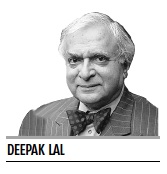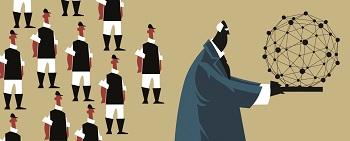 While the digital revolution has provided many benefits, there are many threats as well, such as from the possible advent of killer robots
While the digital revolution has provided many benefits, there are many threats as well, such as from the possible advent of killer robots
by Deepak Lal
A recent paper by Roland Strausz (‘A Theory of Crowdfunding’, American Economic Review, June 2017) shows that crowdfunding sites such as Kickstarter increase economic efficiency when there is demand uncertainty, by allowing entrepreneurs to contract with consumers before the development of a product. This allows them to screen for valuable products even if there is moral hazard from the possibility of the entrepreneur embezzling rather than investing the contracted funds. It also provides consumers an incentive to reveal private information about their demand. The former is controlled by deferred payments of unannounced size in the market once the project is complete. The second by Kickstarter’s practice of defining an individual pledge level and a target level for all the pledges. During the campaign period of 30 days the aggregate pledges are announced, allowing consumers to condition their decision to pledge on the contributions of previous consumers. If these aggregate pledges fall short of a pre-announced target, the crowdfunding campaign is declared a failure and the project is cancelled. Only if the pledges exceed the target will consumers be asked to pay their pledges, which are transferred to the entrepreneur to undertake the project. This all-or-nothing target is shown to be the crucial feature for conditioning investment on revealed demand. Furthermore, after the project is completed it will also have an “after-market” — after meeting the pledged demand. Consumers valuing the product will stop pledging after the target is reached and wait to buy the product in the after-market. The crucial deferred payments to control moral hazard come in this after-market. Thus crowdfunding by reducing demand uncertainty complements the traditional entrepreneurial financing (through banks or venture capital) primarily focused on controlling moral hazard. This crowdfunding innovation based on the digital revolution clearly raises social welfare.
What of those based on the use of
AI? There are three concerns about
robots. The first is the fear of mass technological unemployment. The second is that they could replace or enslave humans. The third is that they could lead to robot wars.
On the threat of technological unemployment and the fear that labour-abundant economies such as India will not be able to develop using their demographic dividend through labour-intensive exports, elementary economics can dispel these fears. Unless the robotic
technology for producing goods is superior (in the sense of using less of both capital and labour) than the existing labour-intensive technology, relative factor prices (the wage-rental ratio) will determine whether the robotic techniques will be adopted (see my
Men or Machines, ILO, 1978). Thus, construction sites in the West are dotted with cranes whilst in India scaffolding on which labourers move materials are ubiquitous. Whilst Ricardo’s law of comparative advantage in international trade – a counter-intuitive but deductively true economic law – ensures that no matter if the rest of the world produces every traded good at a lower cost (say using robotics) than India, it will still have a comparative advantage in producing and exporting goods in which its relative domestic costs are lower, which will be at the labour-intensive end of the spectrum. What is needed is to ensure that factor markets – particularly for labour and capital – reflect their true opportunity costs. This requires removing the distortions in labour markets from colonial labour laws worsened during the Nehruvian settlement.
On the danger of
robots taking over the world, there are some philosophical confusions concerning computers and human brains which are relevant. These have been set out most clearly by John Searle (
The Mystery of Consciousness, Granta Books, 1998). The starting point is the mind-body problem beginning with Descartes’ statement “
Cogito ergo sum”. This dualism was effectively attacked by Gilbert Ryle who described Descartes’ view of the mind as the “ghost in the machine”. This dualism is no longer accepted by philosophers and cognitive scientists. The mind is just part of the brain. Computer scientists, however, claim that the brain is just a digital computer, and the mind is just a computer program (software). This Mr Searle calls Strong
AI — to be distinguished from Weak AI, which sees the computer as a useful tool in doing simulations of the mind. The main distinguishing feature of the brain from a computer is consciousness which is associated with the subjective feeling like “pain” arising from various internal and external stimuli. Mr Searle argues that the brain is an organic biological machine. “Consciousness is caused by lower level neuronal processes in the brain and is itself a feature of the brain”. Computers are immensely useful in simulating brain processes. “But the simulation of mental states is no more a mental state than the simulation of an explosion is itself an explosion” (pp 17-18).
Recent developments in neuroscience lucidly summarised by the UCLA neuroscientist Joaquin Fuster (who pioneered the exploration of the brain’s prefrontal cortex) in his The Neuroscience of Freedom and Creativity, Cambridge 2013 shows the brain is a complex general equilibrium system translating perceptions into goal-directed actions in which the pre-frontal cortex plays a major role. Many of these actions are based not on certainties but Bayesian probabilities which allow a great deal of latitude in choosing among various actions and hence to “free will”. The cerebral cortex also guides conscious attention, where consciousness “is that condition that evokes the subjective awareness of ourselves and of the cognitive and emotional functions our brain performs.”
Even
AI scientists now realise that their dream of replacing humans with
robots or cyborgs depends on answering what the MIT physicist Max Tegmark (in Life 3.0, Allen Lane 2017) calls the really hard question: “Why is anything conscious?” Though hopeful for an answer leading to conscious robots, I remain doubtful. The brain is a biological organ and though a silicon brain can simulate many of its performances I doubt that it can provide a substitute.
The final fear is more rational. This is of an arms race in the development and deployment of autonomous weapons — killer-
robots. We already have drones, but these always have a human in the loop. But Mr Tegmark reports that “development is now under way of truly autonomous weapons that select and attack targets entirely on their own.” This raises many questions to be discussed in a future column.
In conclusion, whilst the digital revolution has provided enormous benefits, and many of the fears concerning its economic and human effects are unfounded, there are serious dangers from platforms used as ad agencies and social media, and the threat of autonomous weapons for which public action may be needed.
Deepak Lal is the James S. Coleman Professor Emeritus of International Development Studies at the University of California at Los Angeles, professor emeritus of political economy at University College London, and a senior fellow at the Cato Institute. He was a member of the Indian Foreign Service (1963-66) and has served as a consultant to the Indian Planning Commission, the World Bank, the Organization for Economic Cooperation and Development, various UN agencies, South Korea, and Sri Lanka. From 1984 to 1987 he was research administrator at the World Bank. Lal is the author of a number of books, including The Poverty of Development Economics; The Hindu Equilibrium; Against Dirigisme; The Political Economy of Poverty, Equity and Growth; Unintended Consequences: The Impact of Factor Endowments, Culture, and Politics on Long-Run Economic Performance; and Reviving the Invisible Hand: The Case for Classical Liberalism in the 21st Century.
Visit Dr. Lal’s Archive Here…
Related
Related
 While the digital revolution has provided many benefits, there are many threats as well, such as from the possible advent of killer robots
While the digital revolution has provided many benefits, there are many threats as well, such as from the possible advent of killer robots

